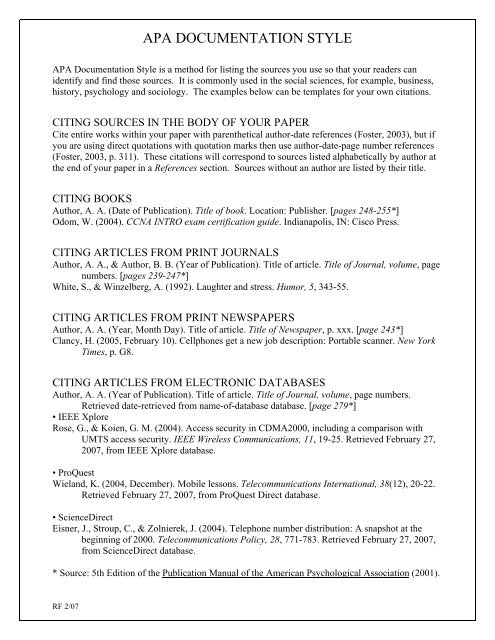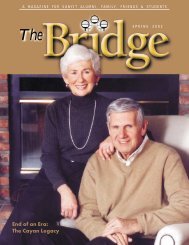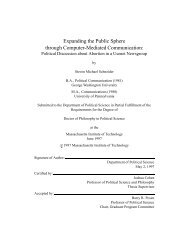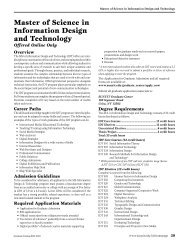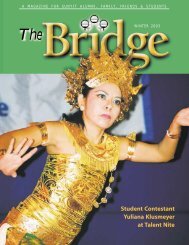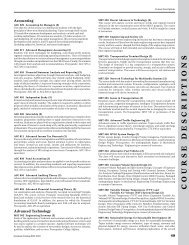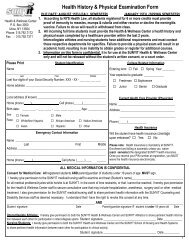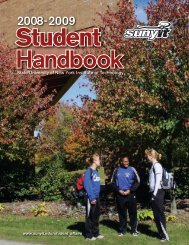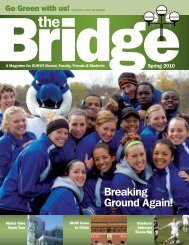APA Documentation Style is a method for listing the sources you use ...
APA Documentation Style is a method for listing the sources you use ...
APA Documentation Style is a method for listing the sources you use ...
You also want an ePaper? Increase the reach of your titles
YUMPU automatically turns print PDFs into web optimized ePapers that Google loves.
<strong>APA</strong> DOCUMENTATION STYLE<br />
<strong>APA</strong> <strong>Documentation</strong> <strong>Style</strong> <strong>is</strong> a <strong>method</strong> <strong>for</strong> l<strong>is</strong>ting <strong>the</strong> <strong>sources</strong> <strong>you</strong> <strong>use</strong> so that <strong>you</strong>r readers can<br />
identify and find those <strong>sources</strong>. It <strong>is</strong> commonly <strong>use</strong>d in <strong>the</strong> social sciences, <strong>for</strong> example, business,<br />
h<strong>is</strong>tory, psychology and sociology. The examples below can be templates <strong>for</strong> <strong>you</strong>r own citations.<br />
CITING SOURCES IN THE BODY OF YOUR PAPER<br />
Cite entire works within <strong>you</strong>r paper with paren<strong>the</strong>tical author-date references (Foster, 2003), but if<br />
<strong>you</strong> are using direct quotations with quotation marks <strong>the</strong>n <strong>use</strong> author-date-page number references<br />
(Foster, 2003, p. 311). These citations will correspond to <strong>sources</strong> l<strong>is</strong>ted alphabetically by author at<br />
<strong>the</strong> end of <strong>you</strong>r paper in a References section. Sources without an author are l<strong>is</strong>ted by <strong>the</strong>ir title.<br />
CITING BOOKS<br />
Author, A. A. (Date of Publication). Title of book. Location: Publ<strong>is</strong>her. [pages 248-255*]<br />
Odom, W. (2004). CCNA INTRO exam certification guide. Indianapol<strong>is</strong>, IN: C<strong>is</strong>co Press.<br />
CITING ARTICLES FROM PRINT JOURNALS<br />
Author, A. A., & Author, B. B. (Year of Publication). Title of article. Title of Journal, volume, page<br />
numbers. [pages 239-247*]<br />
White, S., & Winzelberg, A. (1992). Laughter and stress. Humor, 5, 343-55.<br />
CITING ARTICLES FROM PRINT NEWSPAPERS<br />
Author, A. A. (Year, Month Day). Title of article. Title of Newspaper, p. xxx. [page 243*]<br />
Clancy, H. (2005, February 10). Cellphones get a new job description: Portable scanner. New York<br />
Times, p. G8.<br />
CITING ARTICLES FROM ELECTRONIC DATABASES<br />
Author, A. A. (Year of Publication). Title of article. Title of Journal, volume, page numbers.<br />
Retrieved date-retrieved from name-of-database database. [page 279*]<br />
• IEEE Xplore<br />
Rose, G., & Koien, G. M. (2004). Access security in CDMA2000, including a compar<strong>is</strong>on with<br />
UMTS access security. IEEE Wireless Communications, 11, 19-25. Retrieved February 27,<br />
2007, from IEEE Xplore database.<br />
• ProQuest<br />
Wieland, K. (2004, December). Mobile lessons. Telecommunications International, 38(12), 20-22.<br />
Retrieved February 27, 2007, from ProQuest Direct database.<br />
• ScienceDirect<br />
E<strong>is</strong>ner, J., Stroup, C., & Zolnierek, J. (2004). Telephone number d<strong>is</strong>tribution: A snapshot at <strong>the</strong><br />
beginning of 2000. Telecommunications Policy, 28, 771-783. Retrieved February 27, 2007,<br />
from ScienceDirect database.<br />
* Source: 5th Edition of <strong>the</strong> Publication Manual of <strong>the</strong> American Psychological Association (2001).<br />
RF 2/07
<strong>APA</strong> DOCUMENTATION STYLE<br />
CITING WEB SITES<br />
Rules:<br />
1. For works with no author, move <strong>the</strong> title to <strong>the</strong> author position (be<strong>for</strong>e <strong>the</strong> date of publication).<br />
2. Capitalize only <strong>the</strong> first word of <strong>the</strong> title and of <strong>the</strong> subtitle, if any, and any proper nouns. Do not<br />
place quotation marks around <strong>the</strong> title. Put <strong>the</strong> title in italics.<br />
3. Use (n.d.). when a source does not have a date.<br />
4. Provide <strong>the</strong> document's Internet address at <strong>the</strong> end of <strong>the</strong> retrieval statement. Direct readers as<br />
closely as possible to <strong>the</strong> in<strong>for</strong>mation being cited. Whenever possible reference specific documents<br />
ra<strong>the</strong>r than home or menu pages. Provide address that work.<br />
5. When an Internet document compr<strong>is</strong>es multiple pages, i.e., different sections have different<br />
URLs, provide a URL that links to its home page.<br />
6. Do not insert a hyphen if <strong>you</strong> need to break a URL across lines. Instead, break <strong>the</strong> URL after a<br />
slash or be<strong>for</strong>e a period. Fin<strong>is</strong>h <strong>the</strong> citation with a period unless it ends with an Internet address.<br />
7. At a minimum, a reference to an Internet source should provide a document title or description, a<br />
date -- ei<strong>the</strong>r <strong>the</strong> date of publication or update or <strong>the</strong> date of retrieval -- and web site address.<br />
Whenever possible identify <strong>the</strong> authors of a document as well.<br />
• Example A: The Generic Entry [page 231*]<br />
Electronic reference <strong>for</strong>mats recommended by <strong>the</strong> American Psychological Association. (2000,<br />
October 12). Retrieved February 27, 2007, from http://www.apa.org/journals/webref.html<br />
• Example B: Internet Article Based On A Print Source [page 271*]<br />
VandenBos, G., Knapp, S., & Doe, J. (2001). Role of reference elements in <strong>the</strong> selection of<br />
re<strong>sources</strong> by psychology undergraduates [Electronic version]. Journal of Bibliographic<br />
Research, 5, 117-123.<br />
• Example C: Multipage Document Created By A Private Organization, No Date [page 273*]<br />
Greater New Mil<strong>for</strong>d (Ct) Area Healthy Community 2000, Task Force on Teen and Adolescent<br />
Issues. (n.d.). Who has time <strong>for</strong> a family meal? You do! Retrieved February 27, 2007, from<br />
http://www.familymealtime.org<br />
• Example D: Stand-alone Document, No Author Identified, No Date [page 274*]<br />
GVU’s 8th WWW <strong>use</strong>r survey. (n.d.). Retrieved February 27, 2007, from http://www.cc.gatech.edu/<br />
gvu/<strong>use</strong>r_surveys/survey-1997-10/<br />
• Example E: Report From A Private Organization, Available On Its Web Site [page 275*]<br />
Canarie, Inc. (1997, September 27). Towards a Canadian health IWAY: V<strong>is</strong>ion, opportunities and<br />
future steps. Retrieved February 27, 2007, from http://www.canarie.ca/press/publications/<br />
pdf/health/healthv<strong>is</strong>ion.doc<br />
* In<strong>for</strong>mation on citing web sites <strong>is</strong> taken from pages 268-281 of <strong>the</strong> Publication Manual of <strong>the</strong><br />
American Psychological Association.<br />
RF 2/07


